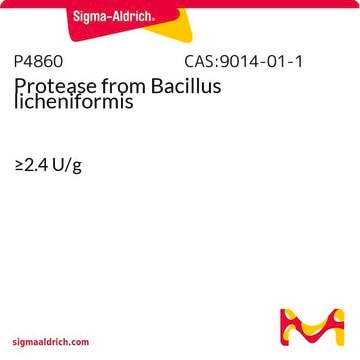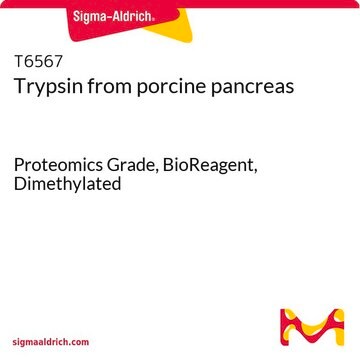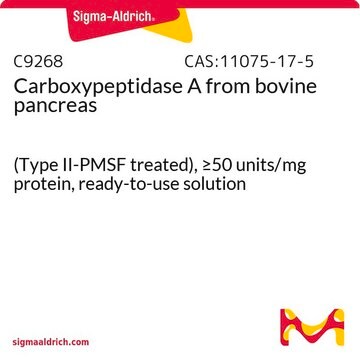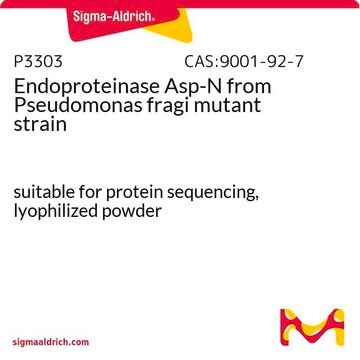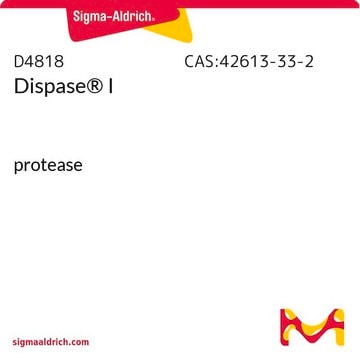The recommended assay buffer includes calcium: 10 mM sodium acetate buffer with 5 mM calcium acetate, pH 7.5 at 37°C. Prepare 100 ml in deionized water using sodium acetate trihydrate and calcium acetate. Adjust the pH to 7.5 at 37°C with 0.1 M acetic acid or 0.1 M NaOH. Additional information can be found at: https://www.sigmaaldrich.com/deepweb/assets/sigmaaldrich/product/documents/390/551/p1512enz.pdf
P1512
Thermolysin from Geobacillus stearothermophilus
Type X, lyophilized powder, 30-350 units/mg protein (E1%/280)
Sinónimos:
Protease from Geobacillus stearothermophilus, Thermophilic-bacterial protease
Seleccione un Tamaño
127,00 €
Seleccione un Tamaño
About This Item
127,00 €
Productos recomendados
origen biológico
Geobacillus stearothermophilus
tpo
Type X
Formulario
lyophilized powder
actividad específica
30-350 units/mg protein (E1%/280)
mol peso
34.6 kDa by amino acid sequence
purificado por
crystallization
Condiciones de envío
wet ice
temp. de almacenamiento
−20°C
Categorías relacionadas
Descripción general
Aplicación
Calidad
Definición de unidad
Forma física
Nota de preparación
Palabra de señalización
Danger
Frases de peligro
Consejos de prudencia
Clasificaciones de peligro
Resp. Sens. 1
Código de clase de almacenamiento
11 - Combustible Solids
Clase de riesgo para el agua (WGK)
WGK 3
Punto de inflamabilidad (°F)
Not applicable
Punto de inflamabilidad (°C)
Not applicable
Equipo de protección personal
dust mask type N95 (US), Eyeshields, Faceshields, Gloves
Elija entre una de las versiones más recientes:
Certificados de análisis (COA)
¿No ve la versión correcta?
Si necesita una versión concreta, puede buscar un certificado específico por el número de lote.
¿Ya tiene este producto?
Encuentre la documentación para los productos que ha comprado recientemente en la Biblioteca de documentos.
Los clientes también vieron
-
Does the enzyme need to add additional Ca2+ and Zn2+ to be activated?
1 respuesta-
¿Le ha resultado útil?
-
-
Can this product be dissolved in PBS?
Can this product be dissolved in PBS?
1 respuesta-
There is no specific information available on the dissolution of thermolysin at a 50 mM concentration in PBS. PBS typically contains between 138 to 150 mM sodium chloride, which may or may not lower the overall solubility of the enzyme in PBS. If PBS is used, the user will need to determine if the enzyme fully dissolves in the solution or not.
For the complete enzymatic procedure, you can find the link here: https://www.sigmaaldrich.com/deepweb/assets/sigmaaldrich/product/documents/390/551/p1512enz.pdf
¿Le ha resultado útil?
-
Filtros activos
Nuestro equipo de científicos tiene experiencia en todas las áreas de investigación: Ciencias de la vida, Ciencia de los materiales, Síntesis química, Cromatografía, Analítica y muchas otras.
Póngase en contacto con el Servicio técnico



